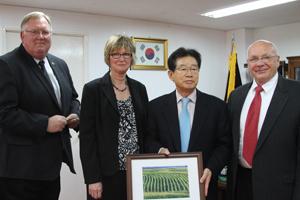Price, price, price … talks this week with major South Korean importers send one message loud and clear: Korea has a strong preference for U.S. corn provided that it is competitively priced.
U.S. Grains Council officers are in Asia this week meeting with longtime customers, addressing concerns about the U.S. short crop in 2012, and discussing the outlook for next year. Korea was their first stop. Korea imports 60 percent of its feed grain needs and has traditionally sourced the lion’s share from the United States. Korean imports from other sources have soared in 2013. As of March 14, corn imports from the United States had sagged to 352,000 metric tons, vs. more than 2.4 million tons at this time a year ago. The reason: price.
“Last year because of price, we had to import corn from [other sources]. I hope that this year the United States will produce enough corn to feed this country,” said Jong Tae Han, chairman of the Korea Corn Processing Industry Association. “We are willing to pay a premium for U.S. corn because of the high U.S. corn quality. We also appreciate the United States as a trading partner. We consider the United States a reliable supplier and friendly nation. Unfortunately, the price gap in 2012 was much too large.”
Nam Jo Cho, chairman of the Korea Feed Association sounded a similar note: “Although we enjoy the quality of U.S. corn, the high prices of 2012 forced us to buy [elsewhere]. The quality was not comparable to U.S. product. We are hopeful that mother nature will favor the United States to produce more corn so we can use quality grain for Korean feed processors.”
“Last year Korea produced 18.5 million tons of mixed feed. To produce that amount, we need 7-8 million tons of corn. Because of high U.S. prices, we had to import much feed wheat in place of corn last year. The quality of mixed feed has not been good due to lack of U.S. quality corn.”
The message came through loud in clear in every discussion with the USGC officers: Korean buyers are united in their appreciation of U.S. corn quality and the reliability of the United States as a supplier. And they made clear that they were as anxious as U.S. farmers for U.S. yields to return to normal in the coming year.
Korea is a highly sophisticated market with the ability to diversify sourcing and reformulate rations in response to pricing. But South Korea is also a longtime, loyal U.S. customer eager to sustain a partnership that has served both nations so well for many years. That is the Council’s goal as well: “We want to maintain our relationship,” said Council Chairman Don Fast, “and the Council will continue to act as the bridge between the Korean customer and the U.S. farmer. That’s what we do 24/7, and our discussions this week show that our partners share that goal.”


